|
|
|
Sort Order |
|
|
|
Items / Page
|
|
|
|
|
|
|
| Srl | Item |
| 1 |
ID:
188068
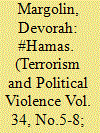

|
|
|
|
|
| Summary/Abstract |
As the debate on whether Hamas should be designated a terrorist organization intensifies across Europe and North America, policymakers and practitioners seek to identify the core principles that unify the group and its ideology. This paper contributes to this discussion by examining how Hamas uses Twitter to frame its narrative to English-speakers around the world. From March 2015 until November 2019, when its account was suspended from Twitter, Hamas operated an English-language Twitter handle under the name @HamasInfoEn. Using thematic content analysis to explore the first 2,848 tweets sent by Hamas in English—between March 2015 and March 2018—this paper explores the socio-political and religious narratives that lay at the core of Hamas’s online public diplomacy throughout its first three years on Twitter. Since its entrance into politics in 2006, some academics argue that Hamas has increasingly sought to distance itself from acts of terrorism and legitimize its actions as a governing actor, thereby seeking to carve out a place for itself in the international community. This study presents a nuanced understanding of how Hamas represents itself internationally, to better understand where the group is going, and how to best counter its narratives.
|
|
|
|
|
|
|
|
|
|
|
|
|
|
|
|
| 2 |
ID:
145626


|
|
|
|
|
| Summary/Abstract |
Two decades later, how should we conceptualize the relevance of the Oslo Accords today? This article reconstitutes our understanding of the Accords through three parameters and purports that the legacy of the Interim Agreement is one that oscillates between what it has failed to achieve with regard to the Palestinian quest for statehood and what it continues to do as a mechanism influencing the “brand” Palestinian politics that can be practiced (uninhibitedly) within the occupied Palestinian territories (oPt). In this way, charting the path for future research, this article concludes that any subsequent studies on Palestinian politics and political behavior would need to account for both what the Accords has not done and what it continues to do.
|
|
|
|
|
|
|
|
|
|
|
|
|
|
|
|
| 3 |
ID:
185263
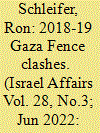

|
|
|
|
|
| Summary/Abstract |
This article examines the violent clashes between Hamas and Israel along the Gaza Fence (30 March 2018–27 December 2019) from a psychological operations (PSYOP) perspective. It shows how Hamas managed, through a skilful combination of mass riots, media manipulation, and quick adaptation to changing circumstances to subvert the strategic priorities of the Israel Defence Forces (IDF), wear down Israeli morale, and erode Israel’s sovereignty in its southern region – all this while deterring Israel from launching a large-scale military operation in Gaza. As such, the Gaza Fence clashes provide an example of a PSYOP-based strategy that can be applied to other border conflict zones, such as Morocco, Saudi Arabia, Mexico, and Islamist insurrections.
|
|
|
|
|
|
|
|
|
|
|
|
|
|
|
|
| 4 |
ID:
092497
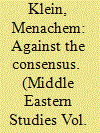

|
|
|
|
|
| Publication |
2009.
|
| Summary/Abstract |
Despite its dogmatic image, Hamas has a tradition of debate in its ranks. It is shown below through critical articles and manifestos composed in the years 1993-2007 by senior members of the movement. The common denominator among all these documents is their critique of the consensus in Hamas. Oriented pragmatically rather than theologically, the writers cover Hamas' most important issues and are diverse in their styles and structures. By analyzing these documents we can peer into Hamas' 'political-ideological kitchen'.
|
|
|
|
|
|
|
|
|
|
|
|
|
|
|
|
| 5 |
ID:
090199
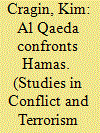

|
|
|
|
|
| Publication |
2009.
|
| Summary/Abstract |
Almost eight years after the September 2001 attacks, U.S. counterterrorism strategy would benefit from a clearer definition of its adversaries. Some have suggested that U.S. counterterrorism policy focus primarily on Sunni jihadists. This term would account for groups such as Al Qaeda and the Abu Sayyaf Group in the Philippines, but not Shi'ite militias in Iraq or Hizbullah. Although any attempt to narrow the scope of U.S. counterterrorism strategy has merit, it is worth noting that important distinctions exist between the various groups. To explore these distinctions, this article examines the different historical trajectories and current arguments between two of the most well-known Sunni jihadists: Al Qaeda and Hamas.
|
|
|
|
|
|
|
|
|
|
|
|
|
|
|
|
| 6 |
ID:
083818
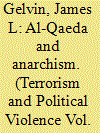

|
|
|
|
|
| Publication |
2008.
|
| Summary/Abstract |
This article situates al-Qaeda and similar jihadi movements within the category of anarchism. In so doing, it challenges the central pillar of the terrorology paradigm: the notion that terrorism is useful as an independent unit of analysis. The article takes a two-fold approach; in the first part, it offers a five-part definition of anarchism, based on the literature in the fields of history, political science, and sociology. Anarchism is distinguished by five characteristics: First, anarchism is an episodic discourse which provides its adherents with a prescription for action and which has been consistently available to, but only sometimes adopted by, political actors in the modern world. Second, anarchism makes for itself the claim of being defensive in nature. Third, anarchism is anti-systemic; i.e., the target of anarchist grievances is the very system (the nation-state system, capitalism) anarchists view as the source of oppression. Fourth, by "othering" the source of oppression, anarchists delineate, either implicitly or explicitly, an ideal counter-community. Finally, unlike the disarticulated domain of, for example, scientific socialism, the discursive field of anarchism draws heavily from the specific cultural milieu from which it springs. The second part of the article examines al-Qaeda and similar movements in terms of these five characteristics, contrasts al-Qaeda with other organizations (Hamas, Hizbullah) which have often been conflated with al-Qaeda under the terrorist rubric, and argues that, based on those characteristics, al-Qaeda does not represent a new or sui generis phenomenon, but rather fits squarely into the anarchist mold.
|
|
|
|
|
|
|
|
|
|
|
|
|
|
|
|
| 7 |
ID:
146854
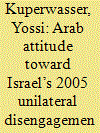

|
|
|
|
|
| Contents |
Brig.-Gen. Yossi Kuperwasser served as the head of the Research Division for Military Intelligence of the Israel Defense Forces in 2005 at the time of the disengagement from Gaza and parts of Northern Samaria. Because of his special vantage point he is able to bring a new insight to the subject. Intelligence professionals were not consulted in the decision-making process. While the Prime Minister and his confidants hoped that this initiative would result in a political advantage for Israel and strengthen its security, it is clear that they did not take possible Arab and Palestinian reactions into account, particularly those of Hamas. In this article Brig.-Gen. Kuperwasser presents the issue of disengagement from a fresh perspective and describes its unintended consequences, which could have been foreseen.
|
|
|
|
|
|
|
|
|
|
|
|
|
|
|
|
| 8 |
ID:
109106


|
|
|
| 9 |
ID:
126056
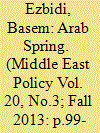

|
|
|
| 10 |
ID:
083925
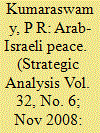

|
|
|
| 11 |
ID:
139991
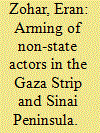

|
|
|
|
|
| Summary/Abstract |
Rebellious non-state actors of the Gaza Strip and the Sinai Peninsula have been arming themselves through smuggling networks operating in north-east Africa and the Middle East. They feature complex, dynamic, open systems which include many components of various organisational and national identities, and which are driven by various motives, united in order to accomplish the goal of arms smuggling. Previously, this system was dominated by the supply of Iranian large and high-quality weapon systems, mainly rockets, to the Palestinian Hamas, enabling them to build up military force that has sustained long-standing conflict against the stronger Israel. The Arab turmoil initiated dramatic changes in the arming system: Iran stopped, at least temporarily, the channelling of weapons to the Hamas due to its support of the Syrian opposition against the Assad regime. Egypt blocked many of Hamas's smuggling tunnels, intensifying Hamas's strategic isolation. Following the removal of Gaddafi and lack of government, Libya became a major arms source, serving mainly regional radical Islamic groups. Salafist jihadist groups in Sinai revolted against the Egyptian government, using huge local stockpiles of weapons and operational cooperation with Palestinian Islamists. This article argues that to survive, rebellious non-state actors must exploit arming opportunities in the physical, social and political environment, whereas securing shared borders is vital for defeating rebellious non-state actors. The arming of non-state actors should be analysed broadly, considering the needs of the civilian population among whom the militants are operating.
|
|
|
|
|
|
|
|
|
|
|
|
|
|
|
|
| 12 |
ID:
085191
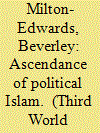

|
|
|
|
|
| Publication |
2008.
|
| Summary/Abstract |
This article outlines the means by which the Palestinian Islamic movement Hamas has developed and implemented a consolidation of power strategy that is inexorably driving it to a state of increasingly authoritarian control in the Gaza Strip. It discusses the factors that have driven Hamas in terms of power seeking as primordial to all radical Islamist movements or as a result of or response to other factors outside its control. The article highlights the concurrent demise of the Fatah organisation in the Gaza Strip as the largest and most visible symbol of secularism. It then reflects on the role of external, including international, actors in accelerating consolidation tactics following the Hamas 'takeover' of power from the Fatah-dominated institutions of the Palestinian Authority (PA) in June 2007. The article aims to demonstrate that Hamas' control in Gaza is an important signpost in terms of developing Islamism in the Middle East region.
|
|
|
|
|
|
|
|
|
|
|
|
|
|
|
|
| 13 |
ID:
191086
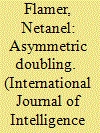

|
|
|
|
|
| Summary/Abstract |
As part of its intelligence warfare against Israel, Hamas made the identification and targeting of collaborators with Israel a top priority. During those years, the Hamas practice was to apply different degrees of detention and torture of those suspected of collaborating. However, in some cases, Hamas chose a different tactic of exploiting collaborators to transform a threat into an opportunity. Hamas turned some collaborators into double agents, using them to advance its objectives. This article examines some of the doubling operations carried out by Hamas on Israeli collaborators over the last three decades. Examining these cases reveal how Hamas’s doubling methods developed over time, concurrently with the movement’s evolution. Thus, the doubling operations became more organized and sophisticated, being used for propaganda and deterrence purposes as well as other goals. The article explores an interesting aspect of Hamas’s counterintelligence activity in its struggle against the state of Israel. In addition, it sheds light on how a nonstate organization can use doubling of sources as part of its asymmetric war against a state.
|
|
|
|
|
|
|
|
|
|
|
|
|
|
|
|
| 14 |
ID:
182999
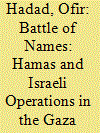

|
|
|
|
|
| Summary/Abstract |
This paper addresses the phenomenon of military operation-naming, that is, the act of giving names to war practices. Based on the four strategies of War Normalizing Discourse theory, I argue that, like nation-states, violent non-state actors also use the tool of naming to disseminate their wartime perceptions and mobilize public opinion for their own interests. Moreover, I argue that in its war-naming efforts the violent non-state actor seeks to defy and undermine the official names of its enemy state, using its own names to expand the physical battlefield to other fields of war and to present itself as an equal and legitimate player. To establish the above arguments, the article presents the case study of Hamas—specifically, the movement’s naming of rounds of fighting against Israel since the beginning of its rule in the Gaza Strip in 2007.
|
|
|
|
|
|
|
|
|
|
|
|
|
|
|
|
| 15 |
ID:
143117
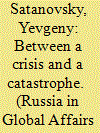

|
|
|
|
|
| Summary/Abstract |
The good thing about our world today is that the spread of information leaves little secret about history. To illustrate this I would like to remind our readers about the Anglo-Russian Convention signed in St. Petersburg in 1907, which left Tibet with China, put Afghanistan under British rule, and divided Iran between Britain and Russia, giving the latter control over the Caspian Sea. If the October Revolution of 1917 had not taken place, the Great Game would have been over. The Sublime Porte shrank enormously after World War I, Russia acquired new territories in Eastern Anatolia under the Sykes-Picot Agreement (a special provision gave Russia control over the Black Sea Straits), and the U.S. presence in the Middle East was barely noticeable, while Britain and France played a leading role in the region.
|
|
|
|
|
|
|
|
|
|
|
|
|
|
|
|
| 16 |
ID:
068238
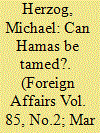

|
|
|
| 17 |
ID:
129872
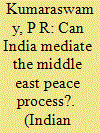

|
|
|
| 18 |
ID:
022340
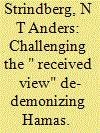

|
|
|
|
|
| Publication |
2002.
|
| Description |
263-273
|
|
|
|
|
|
|
|
|
|
|
|
|
|
|
|
| 19 |
ID:
132476
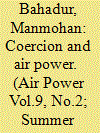

|
|
|
|
|
| Publication |
2014.
|
| Summary/Abstract |
Coercion has been the subject of many a study. To coerce an adversary's thought process and actions to one's own advantage is its end game. Paradoxically, there needs to be a con?uence of interests for discord to occur.' Coercion is not necessarily of the military kind only; in fact, a host of other measures constitute many permutations of actions that can be used to coerce an adversary's decision-making calculus. The North "Vietnamese took on the American military might in their unification effort, and movements and groups like Hamas and Hezbollah periodically fight the Israelis despite the military asymmetry that exists between the two; and the indigenous Afghans, in the long run, were not overawed, first by the might of the Soviet Union and then the Americans. In fact, one study suggests that the initiation of approximately 30 percent of conflicts has been done by the weaker party? Why does this happen and where does air power fit in the equation?
|
|
|
|
|
|
|
|
|
|
|
|
|
|
|
|
| 20 |
ID:
188832
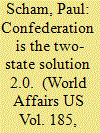

|
|
|
|
|
| Summary/Abstract |
In the wake of the failure of the “classic” two-state solution to make headway since the collapse of the Camp David negotiations in 2000, the idea of a confederal solution to the Israeli–Palestinian conflict is being increasingly seen as a realistic political format by Palestinians and Israelis of both the left and the right. Examples and models of reconciliation and confederation are discussed in this article and certain myths, including that religious strictures are unchangeable, are challenged. The author concludes that confederation is possible, though admittedly difficult, and seems the only viable alternative to the stalemated status quo.
|
|
|
|
|
|
|
|
|
|
|
|
|
|
|
|
|
|
|
|
|